In an atmosphere of great expectation, further heightened by the postponement imposed by the health emergency, the exhibition dedicated to ancient sculptures from the Torlonia Collection, curated by Salvatore Settis and Carlo Gasparri, opened its doors in Rome. Expectations were not disappointed: after so many decades in which this fundamentally important collection had disappeared from view (except for a very few scholars), one can finally admire a superb selection of the marbles gathered by the Torlonia family during the nineteenth century, organized in a clear and linear tour. A path that proceeds backwards, to highlight how the last great Roman princely collection is a “collection of collections,” a composite whole into which have flowed not only excavated pieces, but also more or less substantial parts of collections established in previous centuries. It is a backward path that calls to mind that of another Roman exhibition of this troubled 2020, the Scuderie’s review consecrated to Raphael: but if in that case proceeding backwards in the painter’s life and production did not seem fully justified and seemed rather a quirk of originality, to escape the usual unraveling of exhibitions on single artists, here the choice turns out to be a useful tool to identify the roots of a complex and long-lasting historical phenomenon, such as antiquarian collecting, and to sketch its evolution, up to the concluding insight of the Torlonia Collection. The collection on display in the exhibition is thus intended as a compendium and outlet of four centuries of collecting antiquities in theUrbe: suggestively, the exhibition itinerary concludes with what can be considered the founding moment of this centuries-old phenomenon, the donation to the Roman People by Pope Sixtus IV of the Lateran bronzes, in 1471, and their transfer to the Capitol. From the last room of the exhibition, in fact, visitors can access the Exedra of Marcus Aurelius, where the bronzes are temporarily gathered: the Spinarius, the Camillus, the She-wolf, and the head and hand of the colossus of Constantine (already normally housed, the latter, in the Exedra).
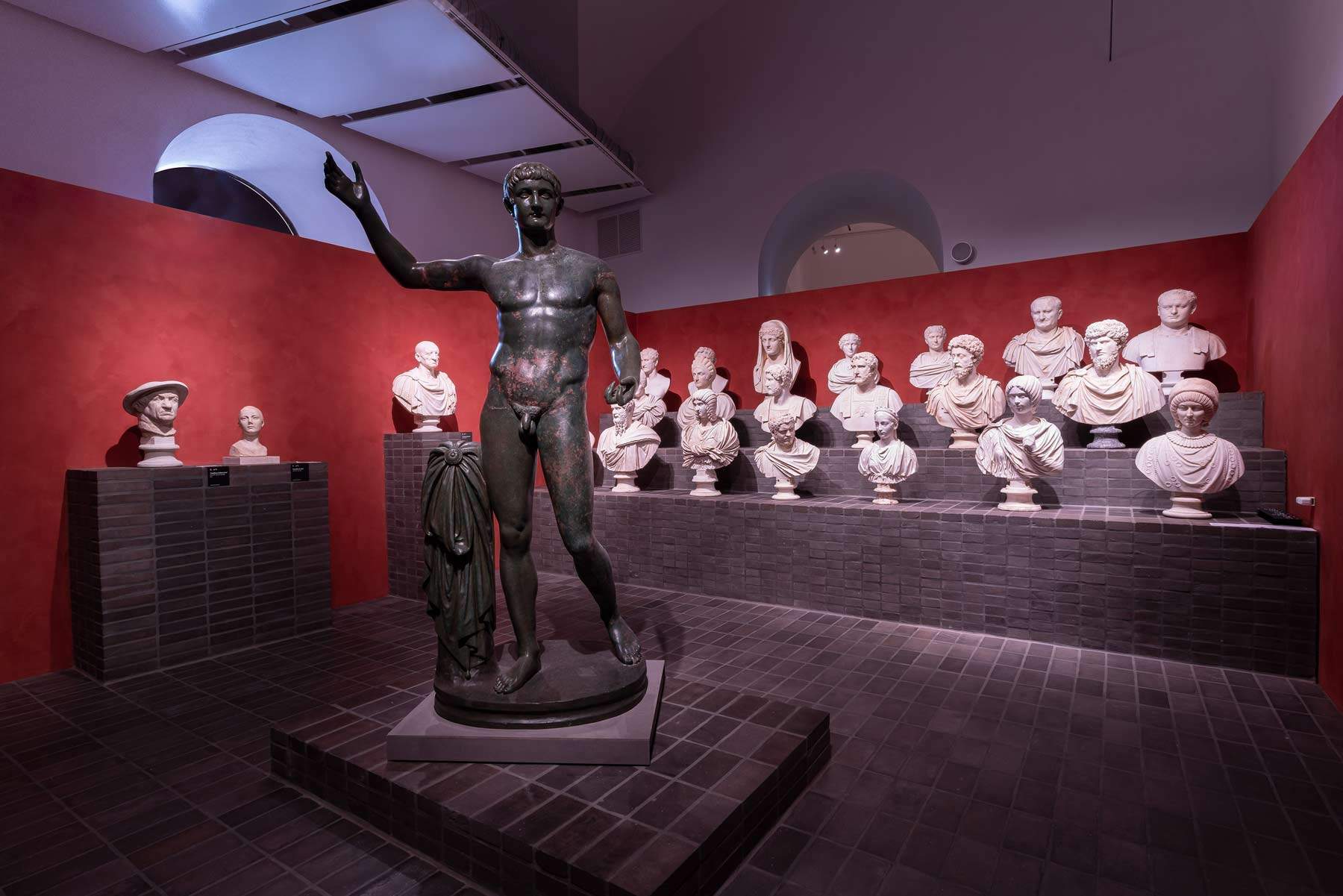 |
| Exhibition layout. Ph. Credit Oliver Astrologo |
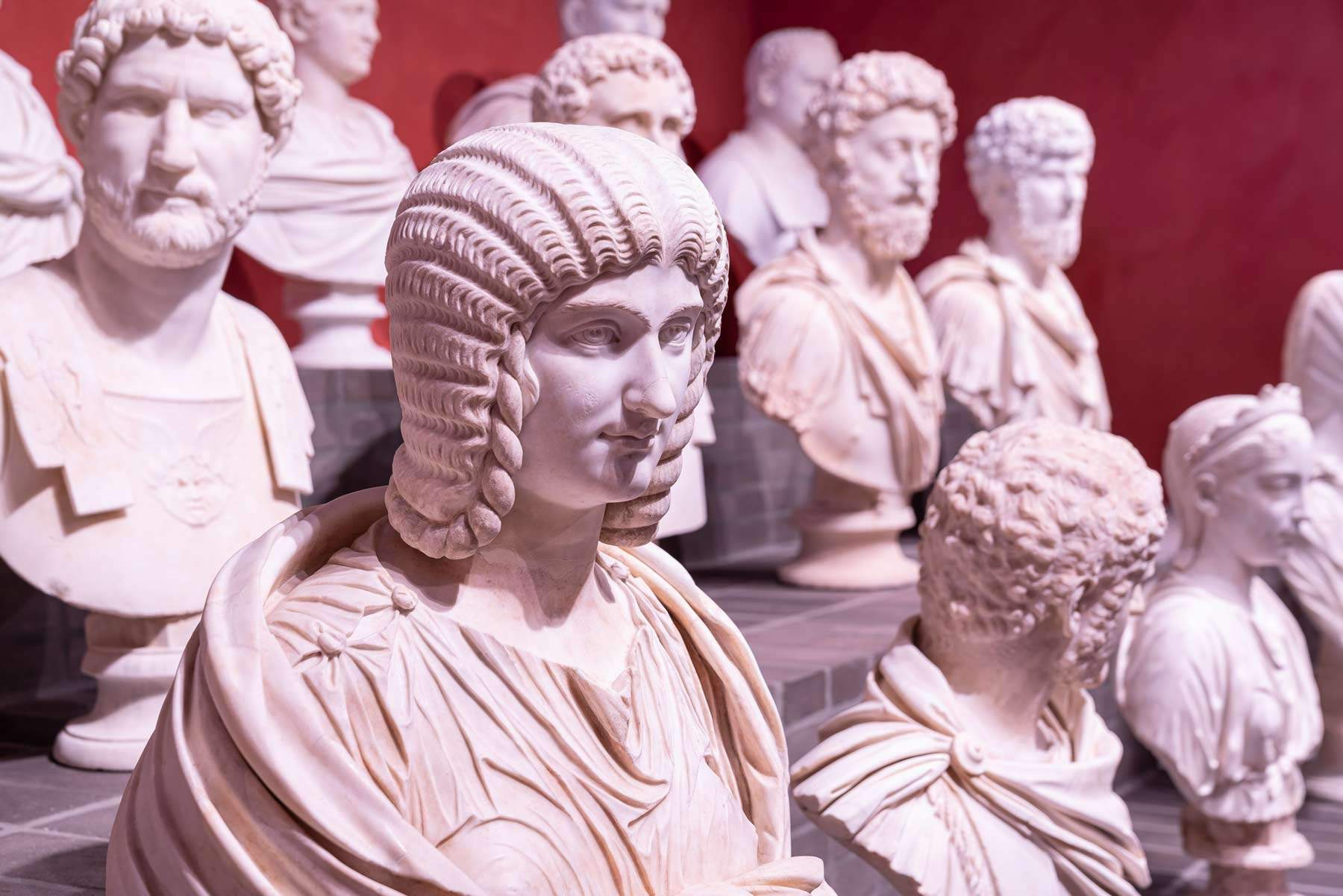 |
| Exhibition layout. Ph. Credit Oliver Astrologo |
From museum to exhibition: the exhibition route
The exhibition starts from the Torlonia Museum, founded by Prince Alessandro Torlonia in 1875 in a palace on Via della Lungara. In the first room, in addition to the only bronze in the collection, a statue of Germanicus from Cures, in Sabina, an exceptional selection of portraits from the imperial age is on display: the portrait collection, emulating and competing with the famous Hall of Emperors in the Capitoline Museums, was one of the museum’s greatest strengths, and at the Lungara it scenographically closed the exhibition itinerary. Slightly removed from the crowd of condottieri and matrons, three sublime pieces from earlier periods are on display: two busts from the late Republican age, the Portrait of a Maiden from Vulci and the so-called Old Man from Otricoli, and a male portrait from the Hellenistic age (the so-called Euthydemus of Battriana).
The second section of the exhibition illustrates the finds made during excavations promoted by the Torlonia family on their estates, with marbles of exceptional interest, such as an Attic votive relief from the fifth century B.C., perhaps originally from the slopes of the Acropolis in Athens, and a relief showing the Portus Augusti, unique for the view depicted and the traces of polychromy still present. With the third section we begin to go back in time, exhibiting works belonging to important 18th-century collections (that of the restorer Bartolomeo Cavaceppi and that of Cardinal Alessandro Albani) that later merged into the Torlonia Collection.
To one of the most extraordinary figures of Rome in the early decades of the seventeenth century, Marquis Vincenzo Giustiniani, is dedicated the next substantial section, which includes rooms 6 to 9. The marquis was a cultured patron and collector (of Caravaggio, among others) and a brilliant art theorist; his lofty collection of ancient statues, celebrated and illustrated in one of the most significant publishing ventures of the time, the Galleria Giustiniana (1636-37), came largely into the possession of Giovanni Torlonia in 1816. Among the rooms devoted to pieces formerly belonging to the marquis, the seventh one stands out, the largest among those in which the exhibition is set up and the one that houses the largest number of works. Welcoming the visitor is the placid gaze of the Caprone Giustiniani, one of the most interesting pieces in the exhibition, not only and not so much for the excellent workmanship of the animal’s body, which is ancient, as for the marvelous head, due to a seventeenth-century restorer in whom Gian Lorenzo Bernini must probably be recognized. Naming the great sculptor for the first time was, in the 1876 edition of the collection’s catalog, Pietro Ercole Visconti, who rejected an earlier reference to Algardi. The Bernini attribution has been much more recently revived by Giulia Fusconi, and on the occasion of the exhibition it is reaffirmed by Tomaso Montanari, who in particular, in his essay in the catalog, juxtaposes the tufts of hair on the goat’s snout with the upright hair of the famous Damned Soul. Pietro Bernini also worked for Marquis Vincenzo Giustiniani, to whom Fusconi and Montanari sensibly attribute the head of one of the two crouching Venuses on display in the exhibition. In addition to the Caprone, the vast room hosts works of various kinds, still a string of busts (ancient, ’mixed’ or not at all modern, such as the very beautiful one of the so-called Vitellius), statues of mythological subjects, decorative elements. Highlighting the serial character of so much sculptural production from the Roman period, the two already mentioned Venuses and two Satyrs at rest derived from Praxiteles’ model are juxtaposed here: it comes spontaneously to mind, also because of the continuous platforms of modest height on which the sculptures are elevated, another Septisian exhibition, Serial Classic, set up at the Fondazione Prada in 2015.
Leaving the Giustiniani masterpieces behind, we move toward the exhibition’s conclusion, pinning wonder-filled gazes on pieces that were once part of illustrious Roman collections formed in the 15th and 16th centuries (Cesi, Savelli, Cesarini, Pio da Carpi), which entered the Torlonia Collection at different times.
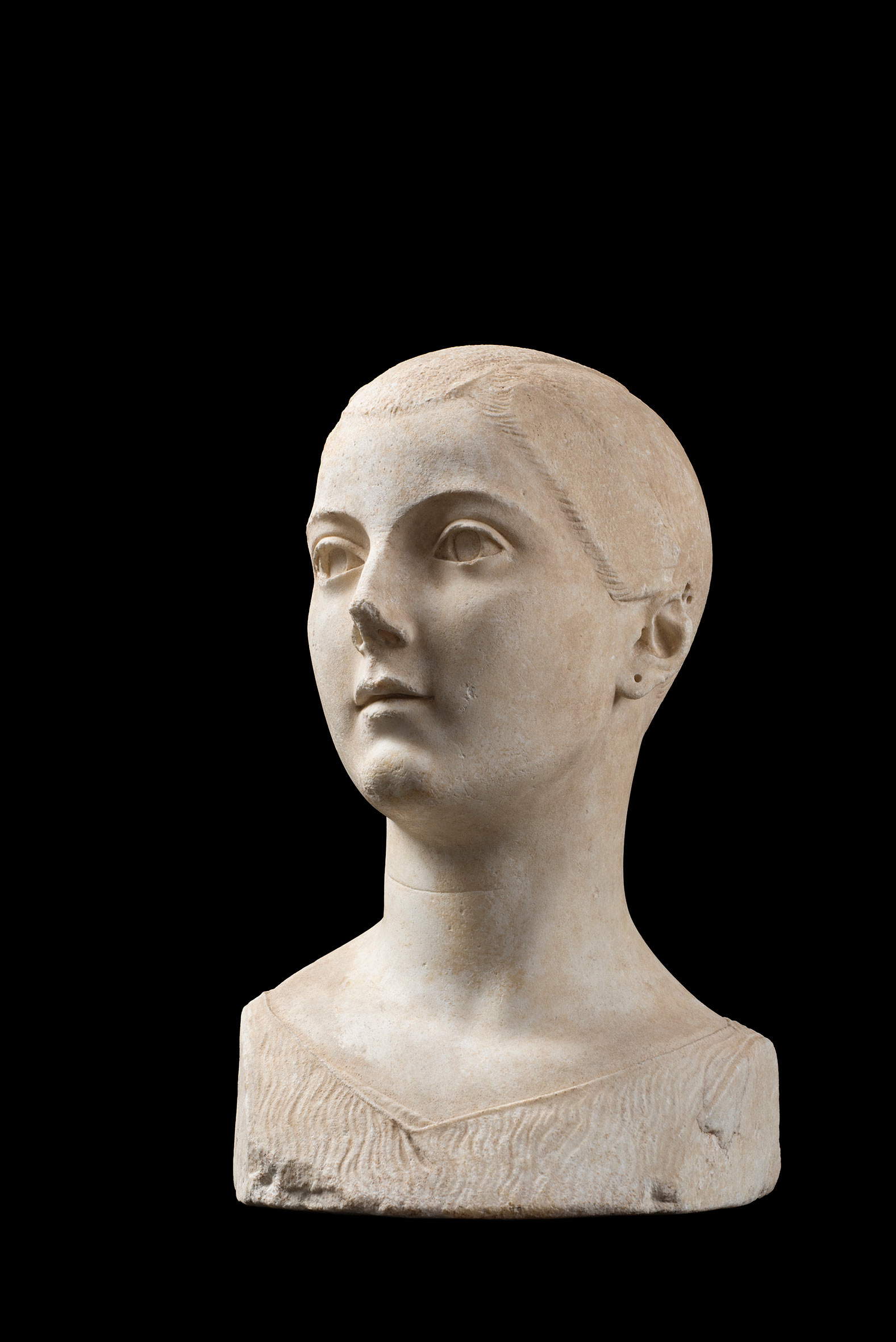 |
| Maiden from Vulci (Luna marble, height 70 cm; Torlonia Collection, Inv. 489). Ph. Credit Lorenzo De Masi |
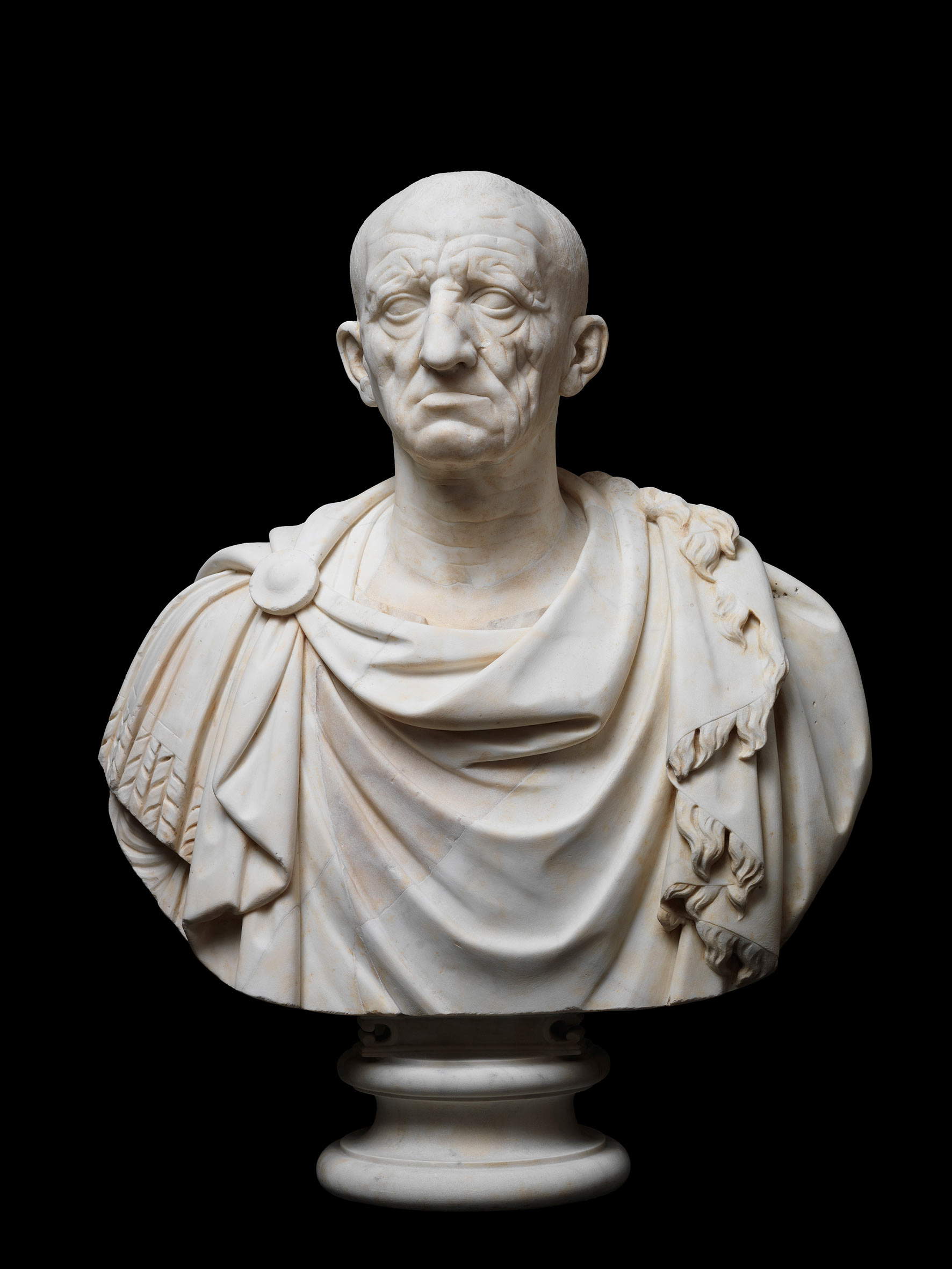 |
| Old man from Otricoli (Luna marble, height 75 cm; Torlonia Collection, Inv. 533) |
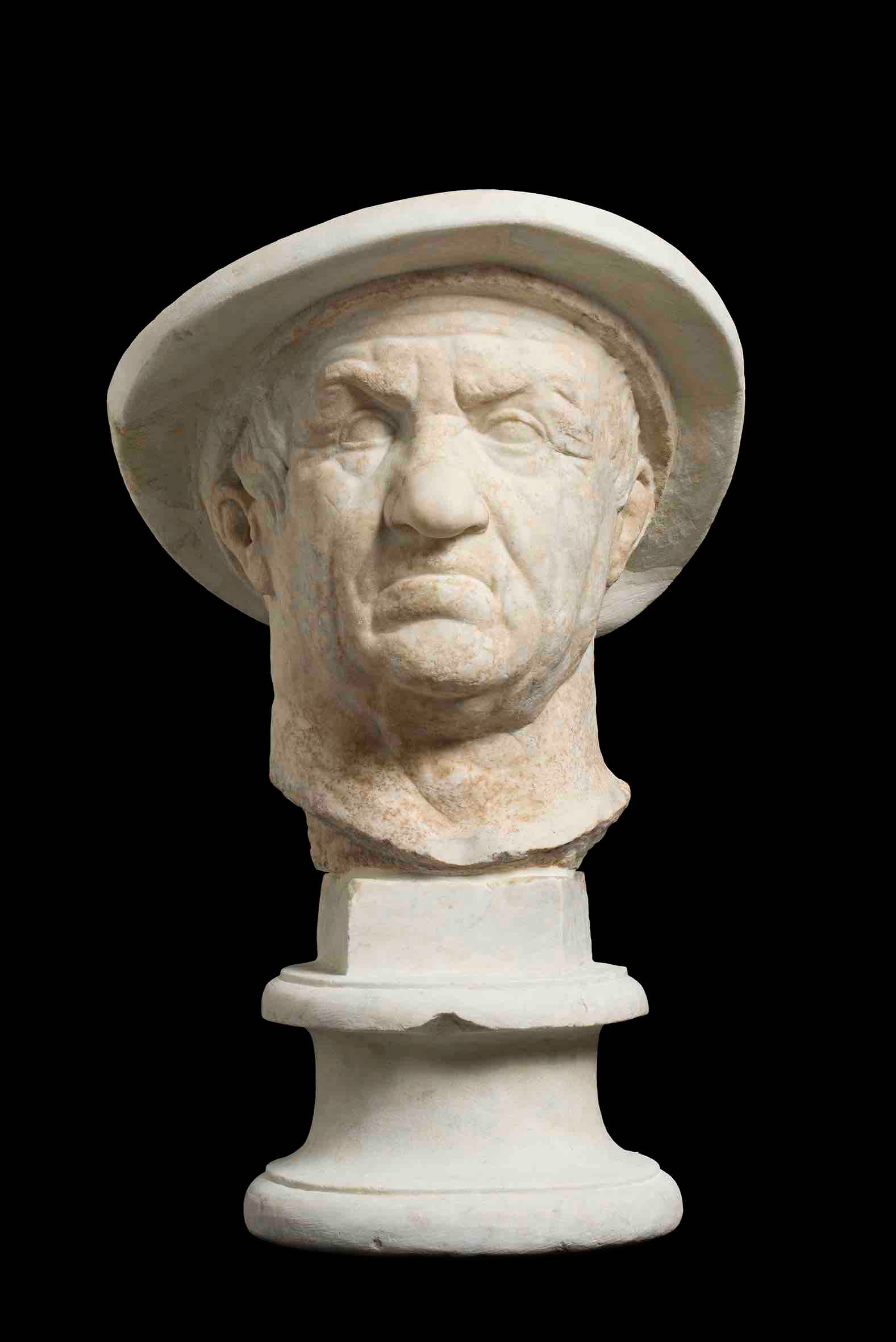 |
| Male portrait known as Euthydemus of Battriana (Greek marble, height 52 cm; Torlonia Collection, Inv. 133). Ph. Credit Lorenzo De Masi |
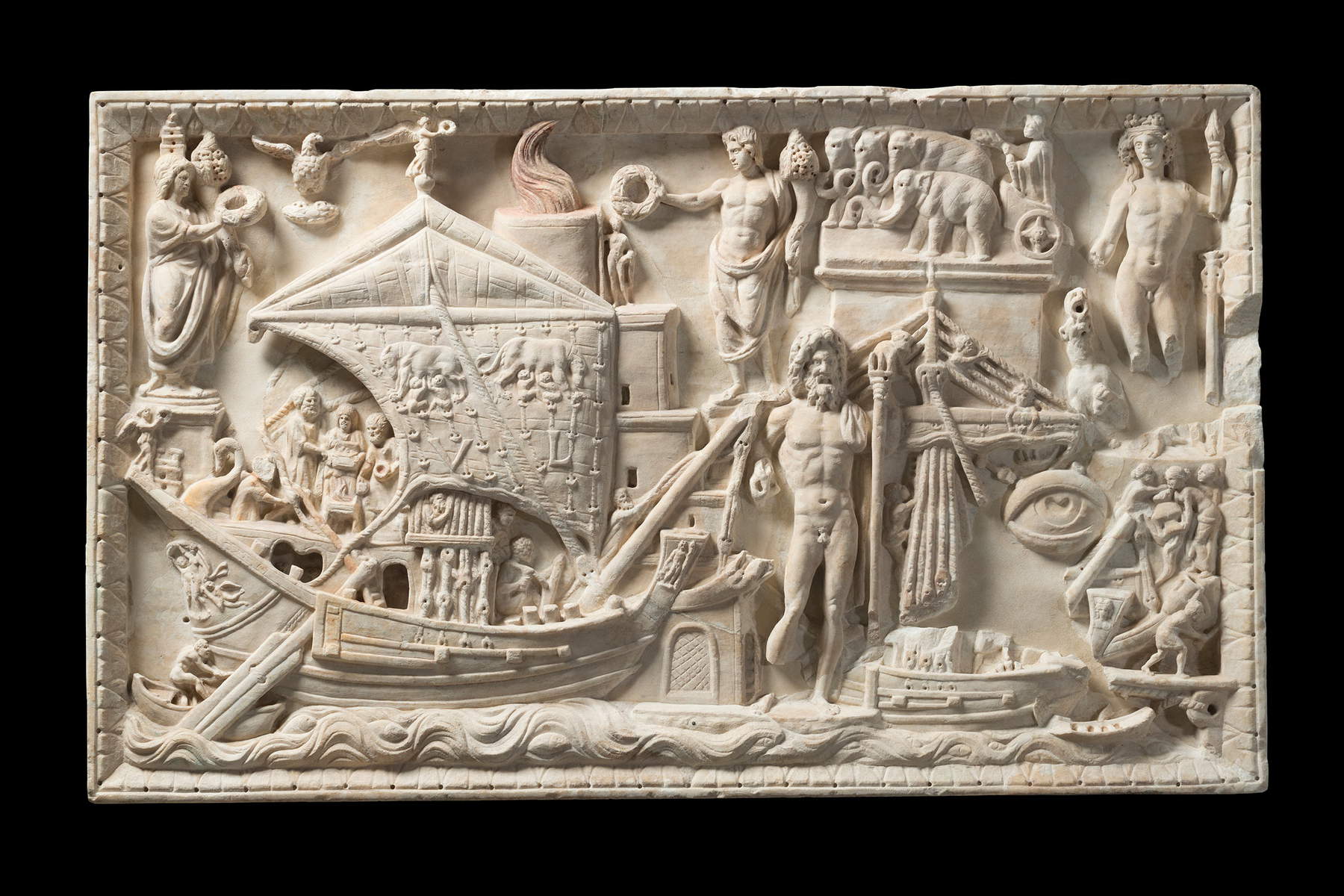 |
| Relief with harbor scene (Greek marble, 122 x 75 cm; Torlonia Collection, Inv. 430). Ph. Credit Lorenzo De Masi |
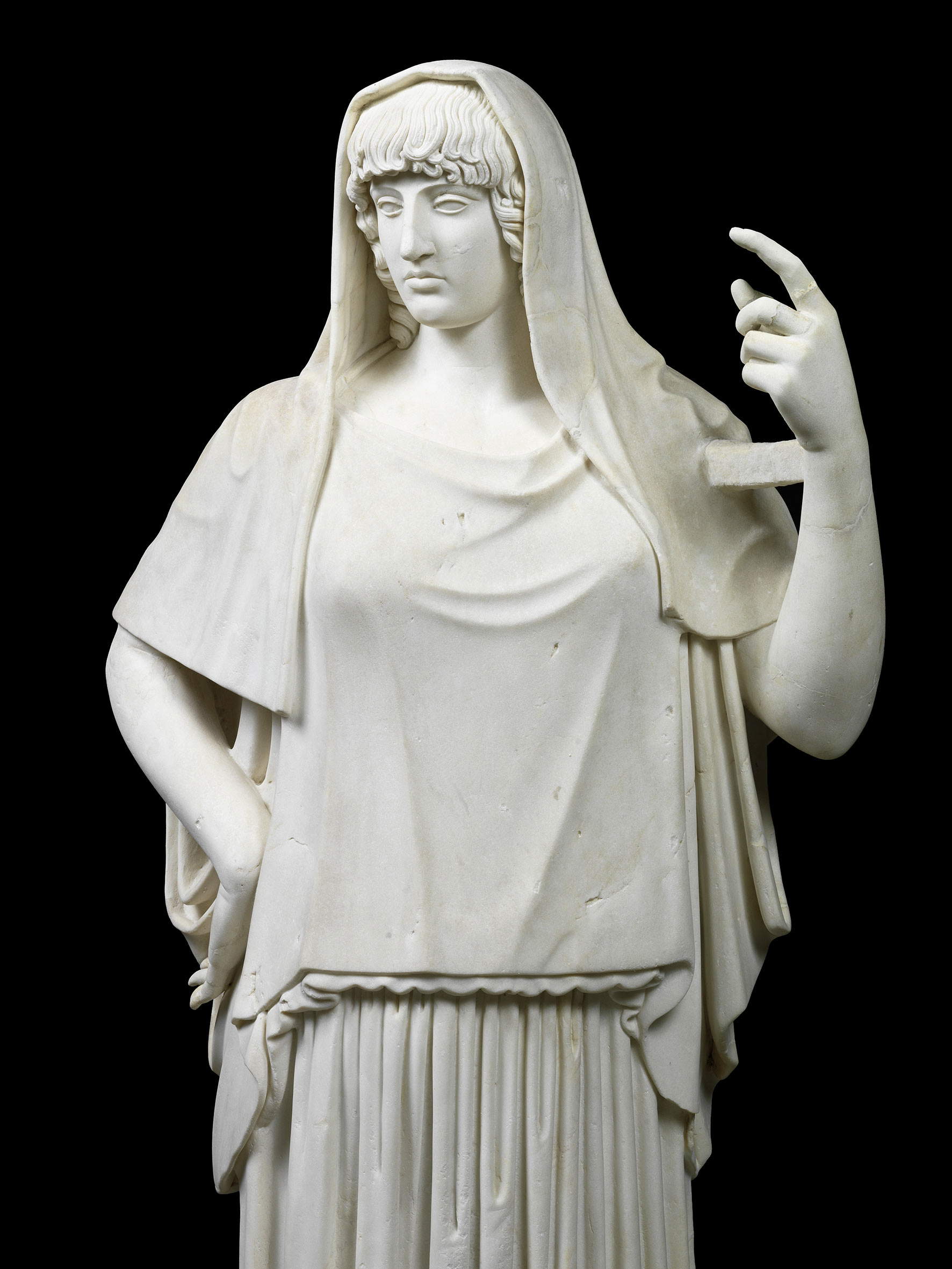 |
| Statue of deity known as Hestia Giustiniani (Parian marble, 200 cm high; Torlonia Collection, Inv. 490). Ph. Credit Lorenzo De Masi |
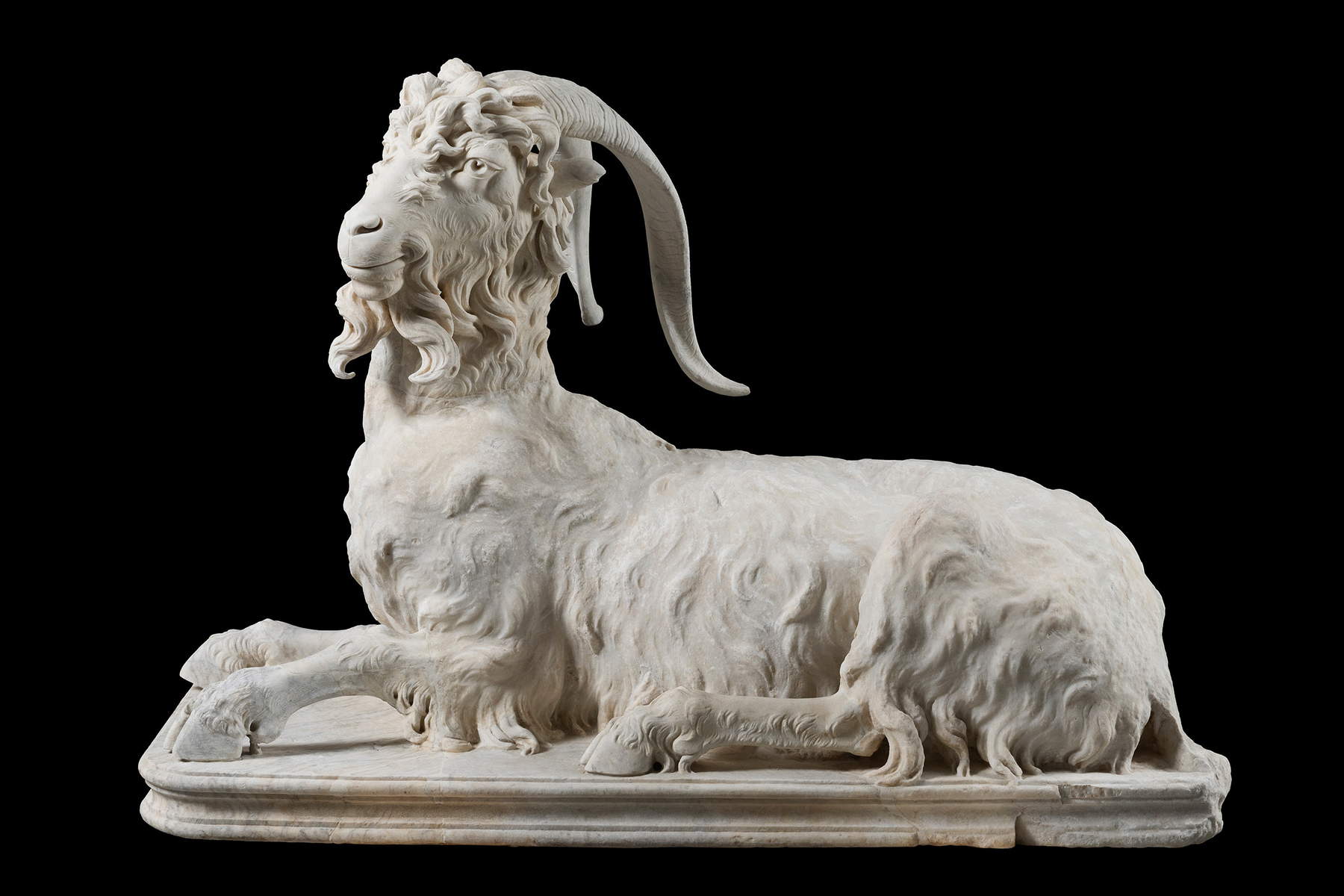 |
| Goat at rest (Greek marble, 132 x 60 cm; Torlonia Collection, Inv. 441). Ph. Credit Lorenzo De Masi |
Spaces and exhibition design
The rooms of Villa Caffarelli that host the exhibition, recovered through careful restoration, fulfill the function of exhibition spaces for the first time, and on the whole they manage. At some junctures they seem insufficient to accommodate so many pieces, and works that are, in some cases, considerably cluttered; especially the last rooms appear rather cramped. It is true, however, that such crowding brings us back to thehorror vacui of historical collections of antiquities, whose vicissitudes the exhibition traces; and the corridors and small rooms in the concluding part of the itinerary seem to hark back to the aristocratic palaces that guarded such collections, where perhaps the ancient piece was revealed little by little at the end of a row of rooms, or behind an ajar door.
The presence of the works in the rooms is articulated by the layout designed by Studio Chipperfield, which is careful to leave a mark, yet without being invasive, as evidenced in particular by the low continuous platforms on which the full-length statues are arranged. All the supports are made of brick, justifying the choice with a reference to the nearby foundations of the Temple of Capitoline Jupiter (which are in truth made of chapel blocks) and more generally to Roman architecture (a reference that seems specious, given that in ancient times the statues did not engage in dialogue with rough brick curtains, but were placed against walls or within niches covered with luxurious marble or covered with paintings). Many visitors did not like this solution: the most malevolent evoked subway stations or typical trattorias. It must be said, however, that, it may be because of the wonder of the pieces on display, the eye soon gets used to theopus latericium, and in the course of the visit no longer pays attention to it.
Finally, a significant aspect deserves mention, namely the fact that the new exhibition spaces of Villa Caffarelli can also be accessed from outside, and that a separate ticket is required to visit the exhibition, and one is not obliged to visit the museum and the temporary exhibition together. This is the first time this has happened at the Capitolini, and it is an event to be welcomed, since it is always good not to force those who want to visit only the museum to have to buy, at an increased price, access to the exhibition as well. However, the problem is not solved in the Campidoglio’s venerable institution, since, alongside the Torlonia exhibition, two other exhibitions (the one on the paintings of the Longhi Foundation and Lockdown Italia) are held in the museum’s halls, which entail a surcharge on the entrance fee. This is how it happens in many places: take it or leave it.
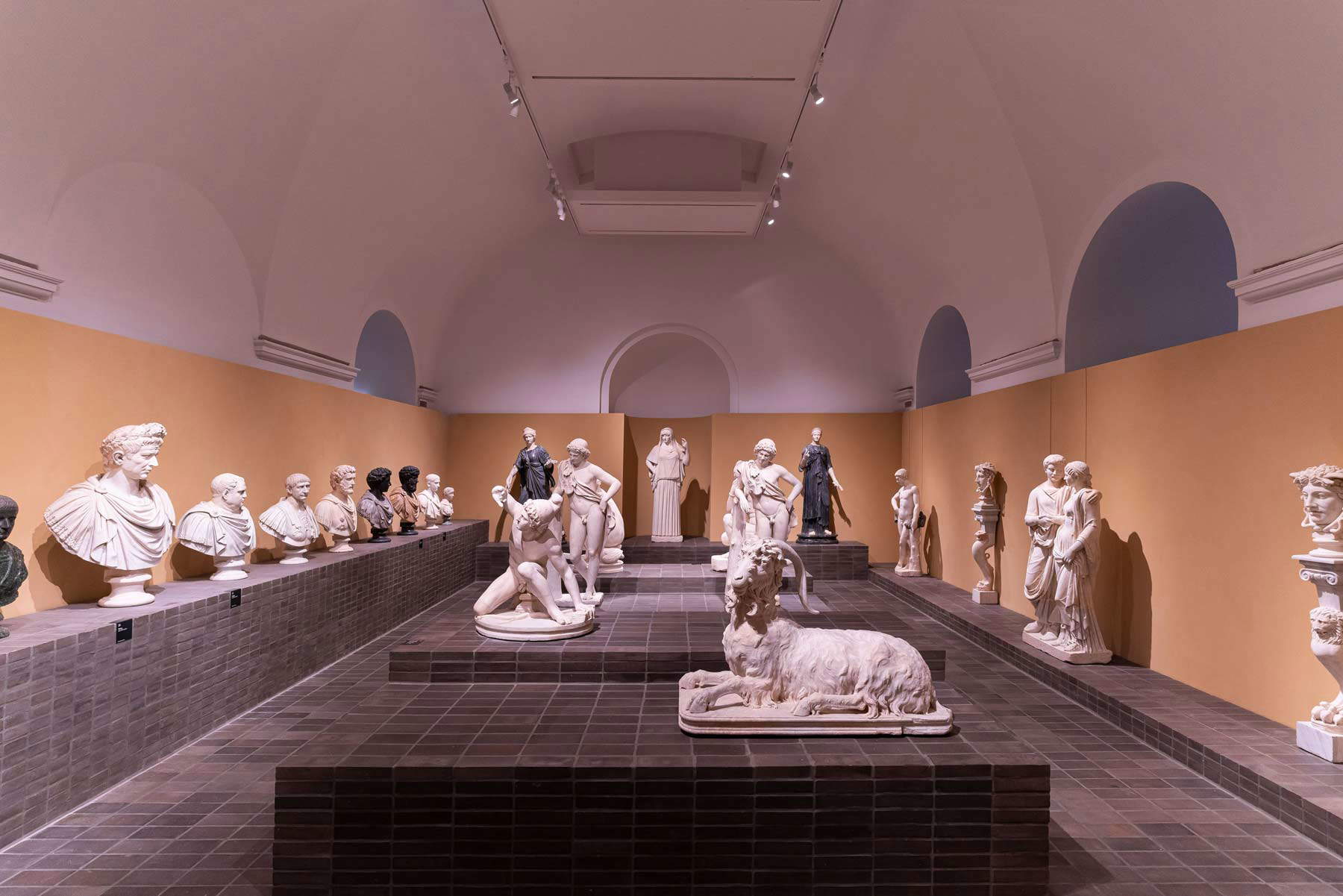 |
| Exhibition set-up. Ph. Credit Oliver Astrologo |
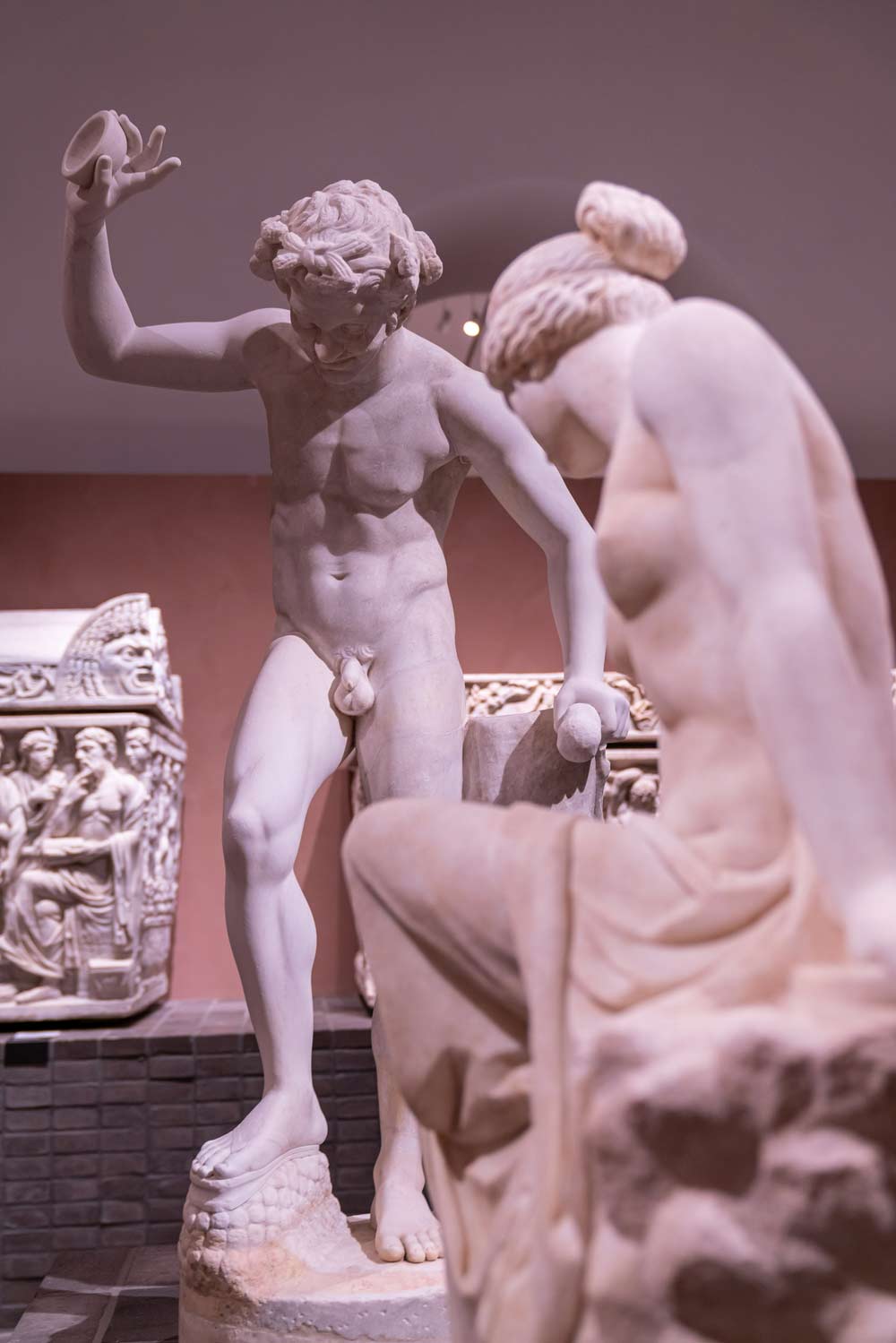 |
| Exhibition set-up. Ph. Credit Oliver Astrologo |
Restorations
Therestorations of ancient sculptures is a theme that the exhibition brings overbearingly to attention, both from a historical point of view, with the statues having undergone more than one intervention in the past, and because the pieces went through a massive restoration campaign in preparation for the exhibition. Absolutely necessary, given that the works, crammed for decades in dusty warehouses, were quite battered; and professionally conducted by a team coordinated by the expert Anna Maria Carruba. One has the impression, however, that, in many cases, a little too much effort was put into the cleaning: often the marbles, due certainly also to the cold light that invests them, appear dazzlingly white. The sculptures, thus rejuvenated, risk looking new, without history. Too evident appear the fractures and joints between the ancient parts and the historical additions (exemplary, in this sense, is the ’cracked’ appearance of theHercules exhibited toward the end of the path, a veritable Frankenstein’s creature reassembled from more than a hundred fragments, including ancient and modern ones); and the diversity, of ’skin’ and color, between the original parts and the additions jumps too much to the eye. To tell the truth, Carruba in his text in the catalog takes care to point out that in the latest interventions, the aim has been to ensure the uniformity of the surfaces of the statues: “Of course, at the present time, no removal or replacement of the inserts due to the ancient restorations has been conducted: volumes and forms have remained intact. What has been the subject of attention is the chromatic value of the surfaces that emerged from the cleaning operations: replaced the degraded Greek pitch with lime mortars and marble dust, the joints no longer emerge as sharp caesuras; muffled by glazes of color, the cold whiteness of the inserts has been brought closer to the warm amber tones of the ancient marbles with transparent glazes” (p. 310). These words are not fully matched by the observable result in the exhibition, where, as mentioned above, ancient and modern are too well distinguished: one contradicts that purpose of unity which guided the action of Baroque and Neoclassical restorers, and which led them to daring operations, such as that of polishing ancient marbles or, on the contrary, boiling in vinegar (or urine) and “tumbling in the sand” the modern parts, so that they would have the appearance of antiquity. In the pieces on display in the exhibition, there was in practice evident, in the living flesh of the marble, that distinction between ancient parts and new additions that would have been better found indicated, as will be said shortly, in the communicative apparatus.
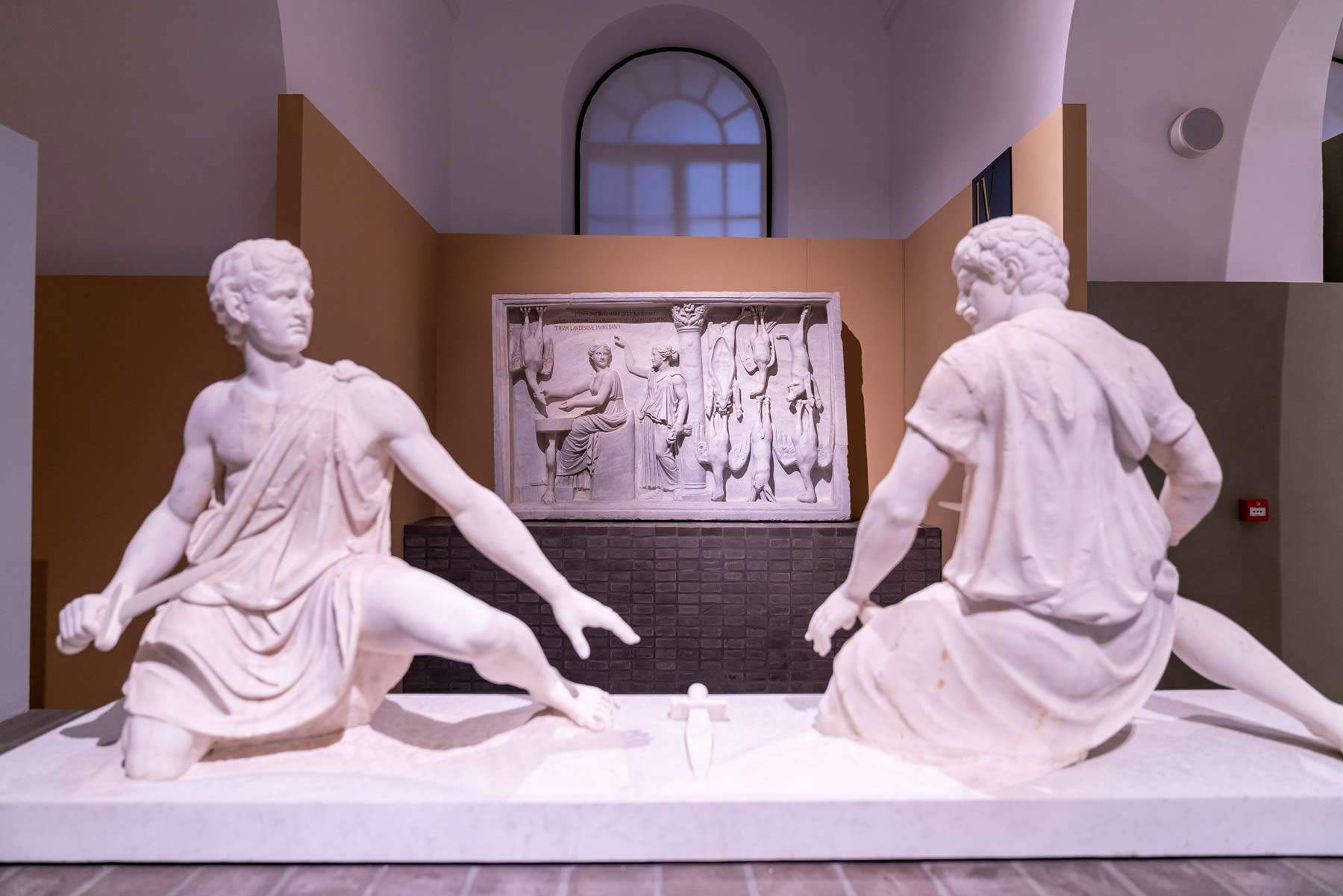 |
| Exhibition layout. Ph. Credit Oliver Astrologo |
Communication
Thecommunication in the exhibition is appropriately concise: the visitor is given essential information, which helps him or her to find their way around the exhibition. Thus, one does not detect the smug verbiage that plagues the information panels of so many other exhibitions. In a sensible manner, the administration of data and news is on several levels, in accordance with the visitor’s preparation and desire to be informed: there is the basic level (as mentioned above, clear and concise) of the panels and name tags, and the vademecum provided at the start of the visit; there is the short guide available for purchase at the bookshop, in which information both on the history of the collection and on individual pieces becomes more richer; and finally, there is the fine Electa catalog, from which the curious can get all the necessary information, thanks to the concise initial essays and especially the exhaustive fact sheets. A very well-kept and effective communication also from a graphic point of view, both in the exhibition, in the catalog and in the promotional material (with ancient heads peeking out from the T of Torlonia).
There is, however, one aspect in the communication in the exhibition that could have been better developed, related to one of the main themes of the exhibition, that of historical restorations: it is true that in the tags it is often (but not always) specified what is ancient and what is not, but these indications do not seem to be the most effective, and in the long run they tire the visitor. And they are not enough to highlight how invasive Modern Age (and much of the 19th century) restoration was, leading sometimes to ’building’ entire figures around modest antique fragments (see, for example, the aforementioned bronze Germanicus and Warrior (cat. 77) displayed in the seventh room). It would have been better to accompany the tags of the works (or at least of the most significant ones in this sense) with graphic reproductions of the sculptures, in which the ancient parts, the modern parts and the additions of irrelevant ancient marbles were indicated through different colors. And perhaps reproduce in some cases (as is done in the catalog) drawings and prints from the sixteenth-seventeenth century, to show how the pieces looked without additions and, above all, provided with additions later removed as taste changed and replaced with those currently visible. The possibility of comparing present and past would undoubtedly have strengthened the viewer’s awareness of how these marbles are not crystallized entities, but living organisms that have changed poses, attributes and, sometimes, identity over time.
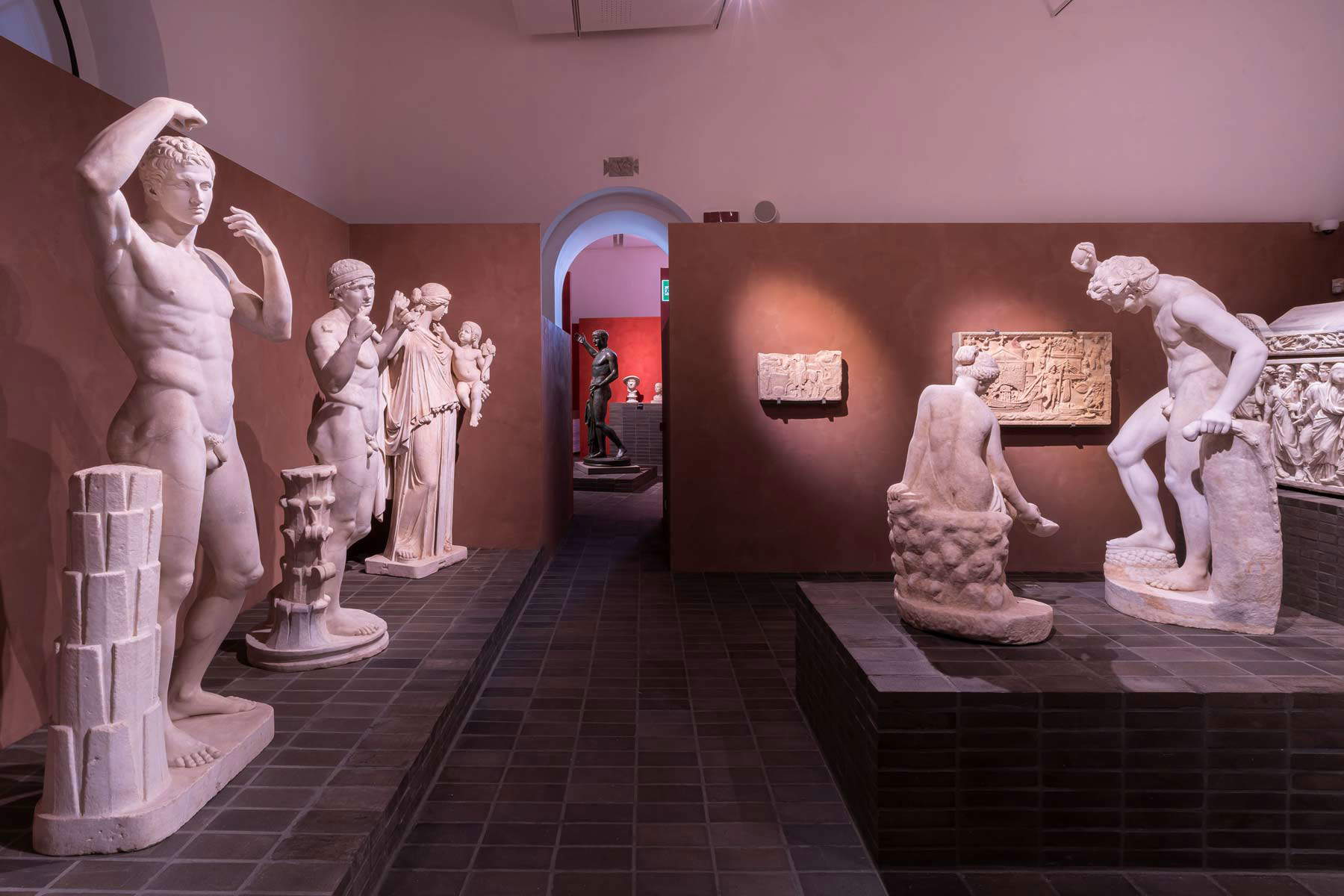 |
| Exhibition layout. Ph. Credit Oliver Astrologo |
From exhibition to museum
The exhibition The Torlonia Marbles. Collecting Masterpieces is therefore a major event. But above all, it is the first step of a path that should lead to the fruition of the entire statuary gathered by the illustrious family, of which a choice is now proposed, yes vast and varied, but reduced, in relation to the overall size of the collection (92 sculptures out of 620 are on display). After the Roman exhibition, the statues will go on tour; little is known about the stops, aided and abetted by Covid, which has spread the cards. For sure, the first foreign institution to welcome gods and busts of the Torlonia family will be none other than the Louvre, as we learn from a text by the museum’s director, Jean-Luc Martinez, included in the catalog. And also known is the final step: a reborn Torlonia Museum that would allow citizens and tourists to permanently enjoy these treasures. A museum, unfortunately, far from coming: as a venue there is talk of the beautiful (and yet to be recovered) Palazzo Rivaldi, near the Colosseum. It is to be hoped that the project, within a reasonable time, will go ahead and that so many capital works of ancient sculpture will be returned, in the words of the inscription celebrating Sixtus IV’s 1471 gift, “Romano Populo, unde exorte fuere.”
Warning: the translation into English of the original Italian article was created using automatic tools. We undertake to review all articles, but we do not guarantee the total absence of inaccuracies in the translation due to the program. You can find the original by clicking on the ITA button. If you find any mistake,please contact us.